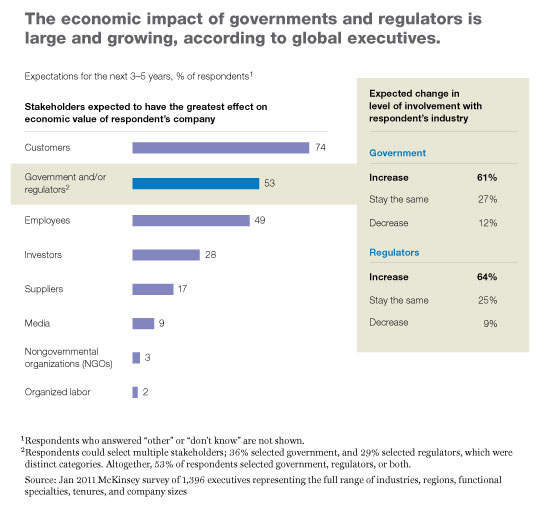The field of behavioral economics is rapidly making its way into the tool kits of regulators.1 In stark contrast, we’ve rarely heard, in our work with more than 300 companies over the past three years, a senior executive consider the impact that cognitive biases might be having on his or her company’s regulatory posture. That’s understandable—people don’t like to think about the mistakes they could be making—but it’s also a missed opportunity. Our sense is that looking at regulatory strategies through the lens of behavioral economics can help clarify the missteps corporate leaders make and the corrective measures they should pursue.
We’re not suggesting that leaders are downplaying the importance of setting an effective regulatory strategy. On the contrary, in a survey of roughly 1,400 global executives we conducted in January 2011,2 more than half of all respondents agreed that governments and regulators will be among the stakeholders with the biggest economic impact on their companies over the next three to five years (exhibit). An even larger proportion expects governmental involvement in their industries to increase over that period—all this despite recent conservative shifts in the United States and the United Kingdom.

Nonetheless, a surprising number of corporate leaders and companies continue to take positions that may seem credible internally but are totally incredible to outside observers and regulators. Simply put, there’s a disconnect between external perceptions and internal beliefs that often undermines efforts to engage productively with regulators. For evidence of this disconnect, consider some other results from our January 2011 survey. Seventy-six percent of global executives responding said they believed that regulators would rate their companies’ reputations as positive. Yet less than a quarter said that their companies frequently succeeded in influencing regulatory decisions. These executives think they’re doing right in the eyes of regulators, but their own, self-reported results say otherwise.
Biases in action
The inflated view many executives hold of their companies’ reputations with regulators is consistent with the well-known cognitive bias of excessive optimism, which tracks with actions we see companies take all the time. (For more on biases and how they can combine to create dysfunctional patterns in corporate cultures, see the interactive graphic “How cognitive biases affect strategic decision making,” in our 2010 article “The case for behavioral strategy.”) For example, until recently most leading smartphone software players seemed to be taking a “less said, best said” approach to the thorny issue of tracking user locations over mobile networks. They have adopted a posture similar to that of Internet companies, which have remained confident that their services’ value to users more than offsets privacy concerns. Observing positions like these, it’s been natural for us to reflect on the experience of several European airport operators, which were so convinced they would never be broken up that they simply didn’t entertain the possibility—until it happened.
A related challenge for companies in regulatory strategy is putting themselves into the shoes of policy makers. Consider the proposals many companies made for grants, loan guarantees, or other government funding as part of the American Recovery and Reinvestment Act of 2009. A surprising number didn’t mention job creation! Similarly, many companies fail to use the “budget math” of entities such as the US Congressional Budget Office to discuss the impacts of proposed legislative or regulatory changes. Others fail to take into account how the cost–benefit functions of government agencies operate or the best way to communicate with them.
Another issue for regulatory strategists is the prevalence of “stability” biases that create a tendency toward inertia. The impact of such biases is acute in regulatory settings because the typical career track of successful executives in many industries—save highly regulated ones, such as telecommunications or electric utilities—doesn’t involve exposure to government issues. As a result, those executives often are personally ill-prepared for shifting political winds that boost the importance of regulatory issues and are prone to underinvest in the regulatory skills of their organizations or to delegate without exercising sufficient oversight. That’s one explanation for the frequency with which companies must rapidly scale up their government-relations function when they or their industries enter the crosshairs of regulators—a phenomenon we saw during 2009 and 2010 as the US health care reform debate heated up.
Countering biases
Addressing cognitive challenges like these is hard because executives can’t change how their brains work. What they can do is put in place processes for challenging entrenched beliefs and approaches. Drafting outside directors or a rotating group of senior managers from inside the company to argue for contrary positions sometimes helps. One European telecommunications company we know created, while it was still a quasi monopoly, a process for generating contrarian scenarios, such as complete breakup. These scenarios helped it recognize the potential for, and successfully pitch to regulators, a milder form of separation.
A good question to ask during sessions like these is, “Why would anyone listen to us?” Leadership teams should subject themselves to this question on a regular basis—perhaps by conducting war games in which they explicitly put themselves in the shoes of other stakeholders or “voice of the stakeholder” exercises in which they interview (and figure out what is most important to) regulators, political actors, and the public at large. Such initiatives boost the odds of taking positions that are well received. Several companies we know used approaches like these to frame their proposals for contracts related to the US stimulus package, and they won five times the funding of counterparts that did not.
There also are steps companies can take to ensure that regulatory strategy is not ignored. One large European telecommunications company has a monthly “reg-watch,” led by the CEO, in which senior managers review emerging issues and a wide range of plausible scenarios, including their financial implications. Getting regulatory strategy on a board’s agenda also helps. And to strengthen organizational muscle, companies should build an exposure to government relations into talent development and job rotation for high-potential managers.
The disciplined embrace of processes like these can help executives avoid embarrassing themselves by taking positions that seem implausible to outsiders. It also may provide a common vocabulary for communicating with regulators as they increasingly employ the tools of behavioral economics. Most important, it should help leaders navigate today’s choppy regulatory waters and achieve outcomes that are sustainable and that serve as a source of competitive advantage against less adroit—and self-aware—competitors.
Learn more about how regulators are applying behavioral economics in “Nudging the world toward smarter public policy: An interview with Richard Thaler.”
